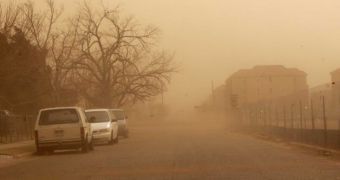Only yesterday, a person was killed and seventeen others were injured as a result of a major dust storm that hit West Texas and caused a series of accidents.
Specialists explain that the underlying causes for this freak dust storm were the severe drought conditions that manifested themselves in this part of the US throughout the past months.
The winds fueling this storm had a speed of roughly 55 mph, and their stirring up impressive amounts of sand and dust significantly reduced visibility.
Because of this, local authorities were left with no choice except close part of Interstate 27 between Abernathy and New Deal on early Wednesday afternoon.
They took this decision after visibility in the area was brought down to zero and as many as 23 vehicles got involved in chain-reaction crashes.
One such crash led to the death of a man whose sport utility vehicle smashed into a tractor-trailer. Seventeen other people were also hurt, but it seems that their injuries are not extensive.
The Dallas News quotes Cpl. John Gonzalez, who stated that, “It was like a white-out, only this would be black. You couldn't see past the hood of your vehicle.”
For the time being, the Texas Department of Public Safety is urging people to remain indoors and avoid traveling.
“[We are] strongly discouraging any travel along the I-27 corridor between Lubbock and Amarillo due to extremely dangerous conditions,” reads one of their press releases concerning this dust storm.
Interestingly enough, it was not very long ago when several researchers went through the trouble of drawing attention to the fact that, as a result of global warming, climate change, and the severe droughts these phenomena bring forth, the US might experience a second Dust Bowl.
“If the drought holds on for two or three more years, as droughts have in the past, we will have Dust Bowl conditions in the farming belt,” argued at one point specialist Craig Cox from the Environmental Working Group.

 14 DAY TRIAL //
14 DAY TRIAL //